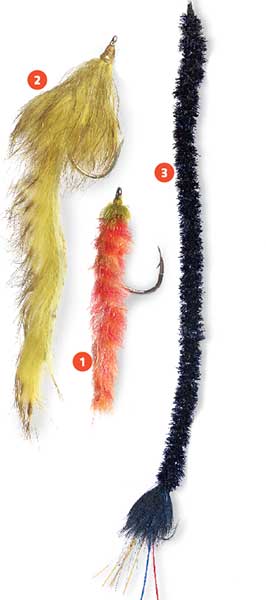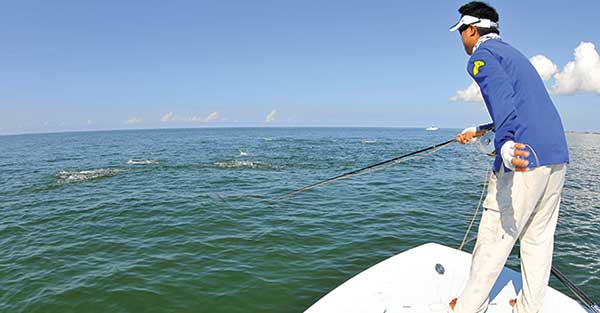In the Florida Keys, the palolo worm hatch turns the tarpon fishing world upside down. Waves of small reddish invertebrates leave the shallows, riding a late-afternoon or evening falling tide in May or June to reproduce out on the reef. The worms trigger in tarpon an astoundingly single-minded need to feed — on them that is. The fish show up in droves to slurp the 2-inch critters with abandon, truly a sight to behold.
A similar invertebrate — the cinder worm — makes stripers go wild in the Northeast. Unlike palolo hatches, which go off around the same time and only in a handful of spots, cinder worm hatches occur at many different locations and times throughout July.
On the Gulf Coast, redfish foraging along oyster bars and in grass flats and marshes readily consume clam worms, peanut worms, and several similar species of invertebrates be it summer, fall, winter or spring. In various parts of California, stripers feed on bloodworms and sandworms throughout the year. So in addition to specific seasonal hatches, worm flies catch fish year-round.
Worms in Your Box?
Most gamefish are opportunistic feeders, and chances are one or more of your favorite target species consider worms a delicacy. So shouldn’t you include some worm flies in your arsenal? The answer is a resounding yes.
Nearly five decades have come and gone since saltwater fly-fishing pioneers like Stu Apte started concocting flies that imitate worms. Few anglers pursued large game in the brine with fly gear back then. Even fewer knew about marine worms, much less about fish’s affinity for them. Nowadays not only do we have indisputable proof, we can watch videos on the subject online.
Digging for Worms
Many saltwater worm flies are neither colorful nor flashy. That makes them less likely to catch fishermen, so fly shops haven’t generally carried a wide selection, but the tide is turning. Already many shops carry tarpon and striper worm flies, more and more are selling comparable patterns for redfish, and a few shops in California that cater to striper addicts are stocking worm flies as well.
For the fly-tier, synthetic fibers and innovative tying materials make creating new fly patterns easier than ever. If you are not that creative, you can surf the Web and find step-by-step instructions to tie someone else’s worm patterns. It always feels special to catch a nice fish on a fly you tied, whether you came up with the pattern or used another’s.
Effective Patterns
1****** **The Chili Pepper Worm, a hot new fly on the scene, is a personal favorite. When wet, it passes for a palolo worm just as easily as a cinder worm, so it is perfect for tarpon and stripers. A 2-inch length of EP Streamer Brush Short Fiber — a cool new material that resembles a disheveled pipe cleaner — forms the body. Its soft stainless wire core gives the fly sufficient suppleness without the excessive fouling you get with softer materials, like rabbit strips.
2****** **The Dredge Worm is another counterfeit I always have in my fly box. It is a simple pattern I came up with years ago. Its original purpose was to tempt redfish tailing, digging for a morsel in the grass, but I have since used the fly around oyster bars and dock pilings with good success. A 4-inch zonker strip (rabbit fur) makes up the head and body. Hidden under it, lead wire wrapped around the hook shank provides enough weight to sink it quickly, yet the fly remains streamlined. A weed guard fashioned from 40-pound fluorocarbon prevents the hook from snagging in the grass.
3****** **The Hogan S.S. Worm, a pattern created in California, is also excellent. It is a whopping 10 to 12 inches long, and has two hooks rigged in tandem with double strands of 50- to 100-pound Spiderwire. The originator had West Coast stripers in mind when he designed the fly, but I suspect cobia wouldn’t hesitate to attack it.
Not Just for Hatches
I’ve tricked many redfish into taking worm flies year-round, and I guess stripers would too. And during my jaunts to the Keys the past few tarpon seasons, I’ve noticed an increasing number of guides using worm patterns well before and after actual hatches. If the pros choose worm imitations, they are obviously confident in their ability to lure the silver king.
Of course, during a hatch, your fly becomes the proverbial needle in a haystack. Think how your chances improve when your fly is not surrounded by millions of identical clones. You get the picture: Worm flies aren’t just for hatches anymore.

worm fly fishing










